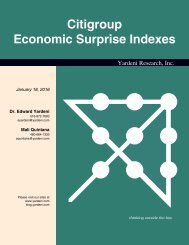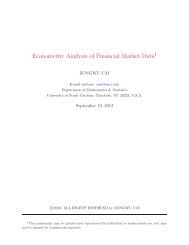Illiquid Asset Investing 1. Liquidating Harvard
Illiquid Asset Investing 1. Liquidating Harvard
Illiquid Asset Investing 1. Liquidating Harvard
You also want an ePaper? Increase the reach of your titles
YUMPU automatically turns print PDFs into web optimized ePapers that Google loves.
Andrew Ang <strong>Illiquid</strong> <strong>Asset</strong> <strong>Investing</strong> <strong>Asset</strong> Management<br />
prices in Panel A appear to be drawn from a series that does not appear excessively volatile; the<br />
standard deviation of quarterly returns computed using the prices in Panel A is 0.23.<br />
[Figure 2 here]<br />
The true daily returns are plotted in Panel B of Figure 2. These are much more volatile than the<br />
ones in Panel B. Prices go below 0.7 and above 3.0 in Panel B with daily sampling, whereas the<br />
range of returns in Panel A is between <strong>1.</strong>0 and 2.5 with quarterly sampling. The volatility of<br />
quarterly returns, computed from (overlapping) daily data in Panel B is 0.28, which is higher<br />
than the volatility of quarterly-sampled returns of 0.23 in Panel A.<br />
For a full comparison, Panel C plots both the quarterly- and daily-sampled returns and just<br />
overlays Panel A and Panel B in one picture. Infrequent sampling has caused the estimated<br />
volatility estimate using the quarterly-sampled returns to be too low. The same effect also<br />
happens to betas and correlations – risk estimates are biased downwards in the presence of<br />
infrequent sampling. 10<br />
3.3 Unsmoothing Returns<br />
To account for the infrequent trading bias, we need to go from Panel A of Figure 2, which<br />
samples quarterly, to Figure B, which samples daily. That is, the quarterly-observed returns are<br />
too smooth and we need to tease out the true, noisier returns. This process is called<br />
“unsmoothing” or “desmoothing,” and the first algorithms to do this were developed by David<br />
Geltner (1991), a noted professor of real estate at MIT, and Stephen Ross and Randall Zisler<br />
(1991). Ross is the same professor who developed multifactor models (see Chapter XX) and<br />
Zisler is a real estate professional who started his career as an academic. Ross and Zisler’s work<br />
10 See Geltner (1993) and Graff and Young (1996) for infrequent observation bias on the effect of betas and<br />
correlations, respectively. Geltner estimates that betas are understated by a factor of a half for real estate returns.<br />
12




